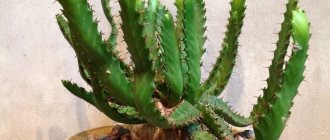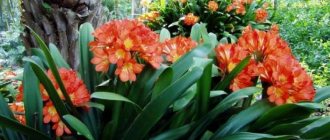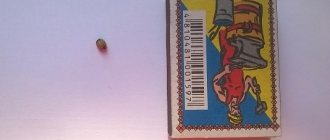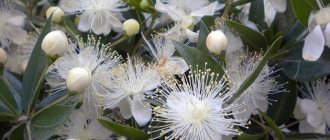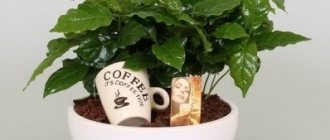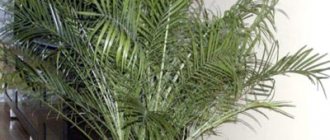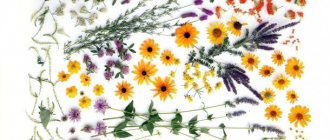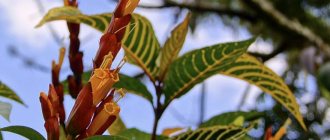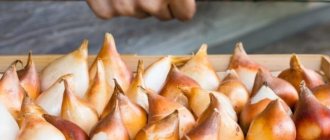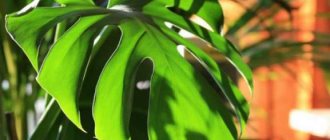The genus Synadenium is directly related to the Euphorbiaceae family. This genus includes approximately 20 plant species, which are represented by succulent trees and shrubs. In nature, they can be found in almost all subtropical and tropical areas. But despite the large number of species, only one is grown at home - Grant's synadenium (Synadenium grantii).
This shrub is very tall. So, in natural conditions it can reach a height of more than 3.5 meters. It is native to the dry regions of South Africa. On the surface of its fleshy, succulent green shoots, a pale gray bark gradually forms. The alternate, short-petiolate leaves have an obovate shape and are smoothly edged. The pale green leaves have clearly visible dark green veins that form a branched tree-like pattern. The length of the leaf plate is 15 centimeters and the width is 6 centimeters.
During the flowering period, thick, short peduncles appear from the upper axils of the leaves, which are few-flowered. They have the shape of an umbrella and bear small, closed, red flowers that look like inverted caps, with protruding tufts of stamens called “feathers.” After the plant has flowered, it produces fruits of the same small size, which are 3-segment capsules with burgundy-colored seeds.
What it looks like, what family it belongs to
South America is considered to be the birthplace of the plant. Syngonium is a prominent representative of the numerous aroid family, numbering more than 30 species. In Latin the name is consonant - Syngonium.
Tropical guest of city apartments syngonium
The appearance of the plant is an evergreen vine with a flexible green stem on which multiple aerial roots are located. At home, vines grow up to one and a half to two meters, dotted with succulent foliage on long cuttings.
Foliage can be various shades of green: from whitish to rich; There are variegated colors: spotted, streaked, veiny.
The flower can be not only green, there are individuals with pink leaves.
Note! Color saturation is determined by the level of illumination in the room. The brighter the diffused light, the darker the color
Indoor syngonium blooms extremely rarely, but if this happens, the plant will delight you with a cob surrounded by a light green blanket, which will turn a little red over time.
Those who want to grow syngonium are interested in whether it is possible to keep an unusual plant at home, and what kind of atmosphere the flower creates in the house.
The tropical guest is believed to have positive energy and is capable of providing healing effects. The flower is useful when surrounded by people suffering from gastrointestinal disorders.
Signs attribute to syngonium the ability to change life for the better - this is due to changes in the growth process. Therefore, people who live in the past are advised to start it at home.
The third belief is associated with the ability to get rid of unpleasant dreams, keep a pot of vines well in the bedroom.
Succulent care
Synadenium is considered an unpretentious houseplant to care for.
Watering and fertilizing
The main problems are caused by a violation of the watering regime: the succulent does not tolerate waterlogging and immediately reacts with drooping leaves, and as a result of constant overwatering, the root system rots. Therefore, it is necessary to water the plant only after the top layer of the substrate has completely dried.
However, complete drying out of the soil mixture should not be allowed when growing this particular species from the Euphorbiaceae family, whose representatives easily lose and restore leaf turgor. In contrast, synadenium drops leaves that have lost their elasticity and no longer returns them to their previous state.
The foliage dries up and falls off, and in its place another, young one will grow, but subject to all the rules of care. Often, to restore an attractive appearance to a succulent, you simply have to trim off the leafless stems to stimulate the growth of young leaves.
Overfilling is also undesirable, especially in low temperatures. The root system in a waterlogged substrate easily rots. Air humidity is not significant in growing this flower. Feed synadenium during the growing season once every 15 days with a mineral complex for succulents and cacti. In winter, the plant rests and feeding is stopped.
A certain role in the decorative appearance of a succulent is played by pruning, which cannot be avoided when growing synadenium plants. The tops of young specimens are pinched to stimulate the growth of side shoots, and older specimens are pruned at the beginning of the growing season. Mature flowers older than 5 years of age will require radical rejuvenating pruning by cutting off 2/3 of the length of the stalks or “to the stump”, leaving 10-15 cm of the height of the main stem from the soil level.
Attention! All work with transplanting and pruning synadenium must be done with rubber gloves to avoid contact of milky juice with mucous membranes or skin.
Synadenium pruning
To add brightness to the room, it is worth purchasing synadenium, caring for it at home is very simple and does not require extra costs. The only drawback is that the plant grows quickly, so it will need to be trimmed often.
In a young plant, it is necessary to pinch the top to stimulate the growth of side shoots, and in older flowers, the shoots are pruned at the beginning of the growing season.
If the plant is already more than five years old, it is worth pruning almost at the very base, leaving about 15 cm or cutting off 2/3 of the length.
Home care
Anyone can grow synadenium at home. Maintenance activities do not require much effort. More difficulties may arise due to the rapid growth of the plant, which often has to be restrained.
Location and lighting
The flower needs bright, diffused lighting. It is better to place it on the western or eastern side of the room. If it is placed on a window in a southern location, the plant needs to be protected from direct sun. This will protect the leaves from getting burned. If there is a lack of light, the shoots of synadenium will begin to stretch out and it will lose its decorative effect.
Soil and drainage
The soil for the plant is light, nutritious with neutral acidity. You can buy a ready-made mixture for succulents or make your own.
To prepare the soil mixture, you need to mix in equal proportions:
- leaf soil;
- peat;
- turf;
- peat.
To avoid root rot in the plant, add a little charcoal to the substrate. Place a drainage layer of expanded clay or broken shards at the bottom of the planting pot.
Planting and transplanting
Young synadeniums require an annual transplant, adults – once every 2-3 years. Since the crop grows quickly, in order to slow down the increase in its size, it is recommended to trim the roots when replanting.
The procedure is carried out in March according to the following scheme:
- Prepare a larger container. Line the bottom with drainage and sprinkle it with a little soil.
- Carefully remove the shrub from the old pot, if possible shake off the old soil (not all).
- Place it in a new pot. Fill the voids with soil, compact it and water it.
Warning! The milky juice of synadenium is poisonous and can cause irritation if it comes into contact with the skin. Therefore, all work with the flower is carried out with rubber gloves.
Air temperature and humidity
Synadenium loves warmth. In spring and summer it is better to keep it at a temperature of +23..26°C. The warmer the room, the more light the plant needs. In winter, it is better to provide the flower with cool conditions (not lower than +10 degrees). Sudden changes in temperature and drafts lead to leaf fall.
The crop is not demanding on air humidity. It can exist normally in the dry air of city apartments. But periodically, the plant can be bathed in the shower to wash off dust from the leaves, or wipe them with a damp piece of cloth. In extreme heat, you can spray water around the bush to prevent it from getting on the leaves.
Watering
Synadenium grows wild in semi-arid regions
Therefore, you need to be careful when watering it. You can moisten the soil only after it has dried 2-3 cm deep
After watering, drain excess liquid from the tray.
It is important to prevent stagnation of moisture in the soil to avoid putrefactive processes. Succulents tolerate drought much more easily than waterlogged soil.
But if it gets too dry, the leaves may begin to fall off. In case of cool wintering, the amount of watering is reduced.
Feeding and fertilizers
During the growing season, the flower needs additional nutrition to maintain its decorative appearance. Every 2 weeks it is fed with fertilizers for cacti or deciduous ornamental crops, alternating with organic matter. You can add them only after watering, so as not to burn the roots.
Trimming
The crop grows very intensively, quickly increasing its green mass. To control such growth, it is necessary to systematically carry out formative pruning. This stimulates the growth of side shoots and makes the bush more lush.
Bloom
The “Tree of Love” blooms in winter in nature. From the upper axils of the leaves emerge peduncles in which inflorescences with small red flowers bloom. Synadenium blooming at home has no decorative value, but the inflorescences give it an exotic appearance. House shrubs usually bloom in summer, during the growing season.
There is a version that the name “tree of love” appeared because of the shape and color of the flowers.
Blooming synadenium
The tree of love or Euphorbia palmum in its natural habitat blooms in the winter season, when flower stalks of varying lengths develop from the upper axils of the leaves, depending on the species.
The arrows are crowned with umbrella inflorescences, consisting of small red flowers, which are shaped like bells. Over time, in place of the flowers, seed pods are formed, divided into 3 segments.
Excellent grapes Nadezhda AZOS: description of the variety, its characteristics and photos
At home, witnessing the flowering of synadenium is very rare.
General description of the flower
Euphorbia synadenium Granta, which is quite easy to care for, grows in tall (up to 3 m) spreading thickets. Over the course of a year, it grows by about 20-25 cm. It is distinguished by branched, deep roots and succulent stems; the branches have sparse lateral shoots. They are erect and very thick. The stems have smooth, dark green skin. Thanks to this structure, the plant stores moisture and is able to survive even in severe drought.
The leaves are attached to the branches using very short petioles. They are located alternately or oppositely. The leaf blade has an obovate or oval shape. The leaves themselves are quite hard, leathery, dark green in color and have a shiny surface. Some varieties have reddish stains or spots. The leaves reach 25 cm in length and 12 cm in width.
Synadenium Rubra is considered more popular among gardeners, compared to Synadenium Grant. The young leaves of this flower are completely pink, then their color changes to dark green, and reddish spots of irregular shape appear.
In winter, small flowers with long elastic peduncles appear on the tree of love, which are collected in corymbose inflorescences. Small flowers look like tiny bowlers or bells, which have short and bent edges. In the center of each flower there are long stamens. After the flower, a small fruit remains in the form of a three-lobed achene with small black seeds.
If you break a stem or leaf, milky juice will be released. It is very poisonous. Causes irritation on the skin, and if swallowed, it can cause serious poisoning, even death.
When growing this flower at home, you need to take precautions and keep children and animals away from it. When pruning Synadenium Granta, you must always use protective gloves.
Description and popular types
Synadenium in the wild is represented by succulent trees and shrubs with thick, erect stems and dense oval-shaped leaf plates, which are attached with short petioles. The arrangement of glossy, leathery leaves is opposite or alternate. In the wild, the genus has about 20 varieties, of which only two are common in indoor floriculture:
- Synadenium Grantii is a branching shrub with numerous shoots. Thanks to pinching, you can achieve the formation of a standard tree. The color is rich green. However, variegated varieties are sometimes found.
Home care
The care rules for all succulents that belong to the Euphorbiaceae family are similar.
Humidity
Euphorbia synadenium is a succulent. This is a class of plants that can accumulate moisture within themselves. Therefore, excess water can only harm it.
The plant is unpretentious to the level of humidity in the room. It quickly adapts to dry microclimates and does not require spraying. But it is recommended to put the plant under the shower from time to time to wash off the dust.
Earth mixture
The plant receives particular benefit from fertilizer. Then the bush will look much more attractive. It must be fertilized from spring to autumn inclusive. Due to the fact that the plant “hibernates” in winter, there is no need to introduce additional feeding.
Synadenium loves loose, but nutrient-rich soil. Therefore, it is recommended to supply it with compost and black peat.
Synadenium Granta is unpretentious to growing conditions
You can use universal and organic fertilizers. There is no need to feed this succulent often. It is enough to introduce additional food every 2 weeks without violating the dosage.
Important! To loosen the soil, you can use sand, charcoal or specialized mixtures. It is not recommended to buy soil for cacti because it is too loose for milkweed
Temperature
The optimal temperature regime for the plant is 22-26 degrees Celsius. Synadenium quickly adapts to other conditions, but if the air cools to +10 degrees, the roots may die.
In summer, it is best to keep the shrub on a glazed and well-ventilated balcony.
Watering
The plant does not require frequent watering. In summer you need to wait until the top layer of soil dries. In winter, you can wait until half the soil is dry. The main rule in caring for this plant is that it is better not to water than to water too much. This should be done only if there is a real need.
Illumination
Like any other plant, synadenium needs diffused light. If there is not enough of it, the succulent will lose its decorative properties. If there is not enough light entering the room, it is recommended to place the bush in a cooler room in order to slow down the growth of the plant. This way you can preserve its decorative properties in low light conditions.
Trimming Features
Synadenium grows quickly, so it is recommended to trim it every year. This will also create the desired shape of the bush. Pruning is carried out in spring. First of all, you need to cut off very elongated and bare shoots.
Synadenium is trimmed with a sharp knife or pruning shears. Branches are cut off at leaf level. After the procedure, milk appears at the cut site, the secretion of which should be stopped using charcoal or activated charcoal.
Important! Pruning is also used to increase the branching of the shrub. It is necessary to cut off the apical growth points at the edges of the shoots
In this way, growth in the lateral buds is stimulated, but the appearance will not suffer from this.
Transplanting a plant
The succulent is repotted almost every year due to its rapid growth. Synadenium can be grown in a pot of any shape and size. The optimal time for transplantation is March-April. In this case, immediately after pruning, you can plant the plant in new soil. The root system can easily withstand this procedure.
Popular types
Evergreen shrubs are represented by two dozen species, and only one of them has taken root as an indoor flower and has become widespread at home. It is known to many as “Euphorium” because it belongs to the Euphorbiaceae family.
Synadenium grantii
Spreading natural thickets stretch to a height of three meters. Over the course of a year of life, the plant adds up to a quarter of a meter in height. Branched roots feed and store moisture in upright and voluminous shoots, which become lignified over time. Oval-shaped leaves on short petioles are attached to the stems either alternately or opposite each other. The leaf surface is shiny, leathery and tough, dark green in color. They can grow up to twenty-five centimeters in length, and up to twelve in width.
Synadenium Granta
Synadenium Rubra
One of the varieties bred from the previous species. It is unusual in that it has purple spots and irregular shapes on the leaves. When young, the “green” appears entirely pink. Natural flowering consists of “shooting out” long peduncles with apical inflorescences of the corymbose type. This event occurs in the middle of winter. The fruits are a box with three doors, filled with miniature black seeds.
The complexity of the content can be caused by only one development factor - rapid growth. It is possible to keep the decorative giant within the allotted limits with the help of regular pruning and pinching. All other maintenance measures do not require increased effort and time. The accumulation of moisture in the trunks of Synadenium, characteristic of succulents, allows the owners to leave the house for some period of time. The ward is able to do without insurance policies for some time. Despite this, there are care features that require regular implementation and do not require large temporary loads.
Watering
It is advisable not to get carried away with abundant hydration and not go to the opposite extreme. Both conditions lead to a deterioration in the condition of the flower. Overwatering can develop into root rot, and drought into wilting. The soil should dry out a couple of centimeters from the top level between waterings. Transitional seasons (spring, autumn) provide for one-time watering for two weeks. In the warm season (summer), the frequency of moistening the earthen ball completely depends on the speed of drying, but at least weekly.
Winter procedures depend on the temperature inside the room. Sensitive coolness and watering at the same time can destroy the plant. It is worth adhering to a monthly schedule (earlier drying of the soil allows for two waterings during the same period). Water is preferably soft, without chlorine (settled), at room temperature. Evenly moistened soil expels excess liquid into the pan. These residues must be drained from it.
Lighting
A very heat-loving pet of plant origin. Having plenty of light is also important. It is permissible to place it on any side of the world. It’s just that each direction has its own specific recommendations. The eastern and western windows can be considered the most optimal. Morning and evening rays do not cause harm.
When “living” on the south side, you will need to create a dispersion of direct solar messengers. This will protect your pet from burns of the leaf plates, which are manifested by yellowing, curling and the immediate appearance of brown and brown spots.
Northern windows should be supplemented with artificial lighting (as well as in winter, regardless of location). Insufficient lighting entails problems of loss of decorativeness. The internodes are drawn out and the foliage is lightened.
Temperature
Euphorbia feels great at year-round temperatures from twenty to 26 degrees Celsius. It does not require a rest period. Adequate lighting and warmth are important. Otherwise, the lack of light will change the appearance of the plant. You can also follow a seasonal regime. Summer time passes with the above indicators. And winter makes fundamental adjustments. A cool room should not cool down below one dozen warm degrees. A decrease to +5, +6 and below can instantly destroy the flower.
Growing and care
There are no special secrets to maintaining an easy-to-care plant. Synadenium is confidently purchased for their home by those who, due to duty, often go on short-term business trips, because the succulent stores moisture in the stems and can easily do without watering for some time.
Accommodation requirements
Indoors, the tree of love prefers to grow on the windowsills of western and eastern windows. The plant loves bright, diffused light, but the scorching rays of the sun are contraindicated for it - brown burn spots immediately appear on the leaf blades.
Lack of lighting also affects the appearance of synadenium - the shoots become longer, the leaves become lighter. In winter, lighting is desirable for succulents.
The plant is thermophilic and in summer it is kept at an ambient temperature of 22 to 26 degrees Celsius. In winter, cooler accommodation is allowed, but not below +10 degrees.
The thermometer readings in the room where the love tree grows during the winter months are directly related to lighting. If the room is warm, more light is required, and vice versa, a cooler microclimate allows less illumination and, therefore, a weak rest period for synadenium.
Transfer
Young specimens are replanted annually, adult plants - once every 2-3 years. Considering the rapid growth and possible large size in an apartment, during the replanting process the roots are slightly trimmed - this procedure will slow down the increase in size of the succulent.
The main components of the substrate for synadenium:
- leaf soil;
- peat;
- sand.
This option is also possible:
- leaf soil;
- sand;
- turf land.
All components are taken in equal proportions, mixed thoroughly and a little charcoal or brick chips is added to the finished soil mixture. A drainage layer of expanded clay or broken ceramic shards must be placed on the bottom.
Watering
When moisturizing synadenium, it is necessary to adhere to the golden mean. Excessive watering leads to the appearance of rot of the root system, which spreads higher - to the root collar and stem. The lack of moisture is compensated for some time by reserves of pagons, but prolonged drying out leads to loss of foliage and death of the plant.
In the summer, the succulent is watered more often - focusing on the drying depth of the earthen ball to 1-2 cm. In winter, watering is reduced, especially it can become destructive at low indoor temperatures.
The humidity of the surrounding air does not play a special role for the succulent. In extreme heat, water is sprayed around the plant from a spray bottle (but not sprayed - rotting spots appear from the drops on the leaf blades). Wipe off dust from the leaves with a damp cloth.
Feeding
From April to September inclusive, synadenium is fed with complex mineral fertilizer twice a month. At the end of the growing season, feeding is stopped.
Crown formation
For better branching, in March, before the start of the active growing season, the tree of love is pruned. Pinching the tops of branches is possible throughout the year; this only makes the crown of the succulent more decorative.
Landing rules
When a crop becomes crowded in a pot, this is clear from its external characteristics - the leaves wither and fall off.
For a new container, choose a stable pot with drainage holes at the bottom.
- Place a thick drainage layer on the bottom of the container.
- Fill half with substrate.
- The plant is removed from the old pot, and the earthen lump is carefully removed. Afterwards, they are placed in a prepared container and filled with soil so that about 1 cm remains from the edge. If it is necessary to restrain growth, some of the roots are cut off.
All manipulations are carried out with protective gloves - the succulent secretes poisonous milky juice, which causes severe irritation of the skin and mucous membranes.
Varieties and photos
In the natural environment, there are about 20 varieties of the plant, but only 2 varieties are used for indoor cultivation - Rubra and Granta. Below are photos and descriptions of synadenium varieties suitable for propagation and care at home.
Granta
The height of the Granta variety reaches 3 meters in height, and thanks to pinching it can be formed into a standard tree. It has a rich green color, but in rare cases the leaves of the plant can be variegated. The oval leaves are arranged alternately or opposite each other and have a shiny surface. The length of the leaf plates reaches 25 cm, and the width is up to 12 cm. The photo below shows Synadenium Granta:
Rubra
The Rubra variety was bred by breeders from a previous species. This variety has large leaves painted with intricate burgundy patterns. Young bushes are pink in color. It is noteworthy that the plant blooms in mid-winter, and not in summer. You can see what the Synadenium Rubra variety looks like in the photo below:
You can see what the bloom of synadenium looks like in the photo below:
Synadenium in the house: benefits and harm
The milky sap contained in the plant is very poisonous. If it comes into contact with the skin, it causes irritation or an allergic reaction, and if it gets inside the body, it causes poisoning. Therefore, you should not place synadenium in places accessible to children.
The plant also has beneficial properties. A tincture is made from the roots of the plant, which is used for diseases of the liver, kidneys, inflammation of the bladder, and headaches. But under no circumstances should you take products containing synadenium without a doctor’s prescription.
Synadenium, despite its African origin, is successfully grown indoors. It is valued by many not only for its decorative qualities, but also for its unpretentiousness. Even novice flower growers who want to quickly and easily green up their interior can grow the crop.
From the following video you can learn more about growing Synadenium at home:
Possible diseases and pests
The main problem when growing synadenium is waterlogging, under conditions of which fungal and bacterial infections become more active. The succulent's root system and stem base rot. However, the lack of moisture also affects the health and appearance of the plant - the trunk wrinkles, the leaves wither, turn yellow and fall off.
Insufficient lighting also affects the decorative appearance of synadenium - the pagons are unnaturally elongated. The plant often reacts to errors in care by dropping leaves - with a sharp drop in temperature, using cold water during watering, an unexpected gust of icy air from an open window, a sudden change in light when changing the location of the flower.
Among the insects parasitizing the plant are mealybugs and whiteflies, less commonly scale insects, as well as spider mites. Depending on the degree of damage, folk remedies or systemic insecticides are used to control insect pests, and acaricides are used against mites.
Home care conditions
Of course, in order for it to grow normally, indoor nightshade must be provided with appropriate care. Fortunately, this is quite easy to do.
Temperature
For the rapid development of home nightshade, maintaining the temperature regime is very important.
- In the warm season, the plant feels best at +20..+25 degrees.
- But in cold weather it is better to lower the temperature to +15 degrees.
Under the right conditions, the plant bears fruit much longer.
It is also worth remembering that it needs fresh air, but at the same time it is advisable to protect it from drafts - the nightshade flower simply cannot stand them.
Top dressing
During flowering and active growth, nightshade needs appropriate fertilizers. The easiest way is to use complex mineral ones. In almost any gardening store you can find special fertilizers for tomatoes. This is the best way to fertilize nightshade so that it grows actively and blooms for a long time.
Of course, you need to carefully follow the instructions so as not to harm the plant.
For reference! When replanting, while the root system is forming, you can apply phosphorus fertilizers - this will speed up the rooting process.
The soil
Experienced flower growers claim that the optimal soil mixture for growing nightshade is made up of peat, leaf humus and turf soil. They need to be mixed in equal proportions.
The resulting soil, on the one hand, is rich in nutrients, and on the other, very light, allowing air to easily pass to the roots, ensuring rapid growth of the plant.
Fruits are the main decoration of the bush
Watering
Of course, if we talk about decorative nightshade, home care will be incomplete without a description of this important factor. Throughout the warm season, from about the end of March to the end of September, the plant needs to be watered abundantly
However, do not forget about high-quality drainage - excess moisture may well lead to rotting of the root system
Throughout the warm season, from about the end of March to the end of September, the plant needs to be watered abundantly. However, do not forget about high-quality drainage - excess moisture may well lead to rotting of the root system.
During the dormant period (from October to February) there is practically no need to water. If the leaves wither, they should be sprayed with a spray bottle. Watering is resumed around mid-February, when the first new shoots appear.
Plant varieties
Synadenium is a flower that has more than 20 varieties, but only a few of them are considered indoor plants that take root at home. It is also called Euphorbia synadenium, because when the stem is cut, the plant begins to secrete a milky liquid. You need to be extremely careful with it, because it is poisonous.
Synadenium Granta
Synadenium Granta
The plant can be up to 3 m in height, has oval-shaped leaves, which are attached to the stem by means of roots. The leaves of Synadenium Granta are very hard and shiny; the length of one leaf can reach 25 cm and the width - 12 cm.
Synadenium Rubra
This plant has already been bred from Grant's synadenium. Synadenium Rubra differs from its predecessor in that its leaves have burgundy-colored spots and their shape has uneven outlines. The plant blooms at home in the middle of winter; it throws out long flower stalks from the very top.
Synadenium Rubra
Reproduction, transplantation, treatment
Synadenium Granta is characterized by resistance to external environmental conditions, is distinguished by high decorative qualities, unpretentiousness and intensive growth. The plant is replanted every 2-3 years, usually in the spring.
To propagate the flower, stem cuttings are used, which are placed in water for roots to grow, and then planted in suitable soil. For better rooting, the cuttings are kept for some time in greenhouse conditions - under a transparent cap.
Milky sap naturally protects the plant from pests, as it is toxic. When growing synadenium, gardeners often encounter not parasites, but yellowing and wilting of foliage. The reason for this is that the indoor microclimate is too cold and dry. Excess moisture leads to darkening and curling of the leaf plate, which means the loss of the decorative qualities of the flower. Leaves also fall if living conditions and the nature of lighting have changed.
The rarely ill and outwardly beautiful synadenium flower is called the “tree of love”
He responds gratefully to human care and attention. They can be used to decorate a window sill in an apartment or country house, in a home or in an office.
The only difficulty in growing this plant is creating favorable conditions around it - acceptable humidity and optimal light.
Features of growing a flower and creating optimal conditions
Despite the fact that the flower is an unpretentious indoor crop, in order to grow a healthy exotic plant in the house, you should take into account a number of its features and create growing conditions close to natural ones.
Requirements for the placement of synadenium and lighting
A native of Africa loves a large amount of bright, but soft light, which he can receive through windows of eastern or western orientation.
If you install a pot with synadenium on the windowsill of southern windows, you should organize shading during the midday hours, when active sunlight can cause burns on the beautiful leaves of the flower.
In winter, when daylight hours are reduced and the temperature remains at the same level, it is recommended to provide artificial lighting to prevent the plant's shoots from stretching.
Temperature
During the period of intense flower growth, the optimal temperature regime is 22-25°C. With the arrival of autumn cold, if it is not possible to install an additional light source, it is recommended to reduce the room temperature to 15°C.
The drought-resistant succulent adapts perfectly to dry indoor air and does not need to additionally increase the humidity level.
As a hygienic procedure, the purpose of which is to clean the shoots from dust, the leaves are wiped with a damp sponge.
Soil requirements
Synadenium is not picky about soil composition and does well in a loose substrate with a neutral reaction. You can prepare the soil mixture yourself by combining equal parts of peat, sand and leaf soil.
Succulent care
Synadenium, the care of which consists of standard measures, will delight the grower with its decorative appearance and excellent health for the care and attention provided. Synadenium being a succulent
drought-resistant and can tolerate lack of moisture for several weeks
Synadenium, being a succulent. It is drought-resistant and can tolerate lack of moisture for several weeks.
But for full development, it is recommended to water the flower during the period of intensive growth as the surface layer of the earthen coma dries out. The rest of the time, it is enough to moisten the substrate twice a month.
The substrate should be enriched with nutrients necessary for the full development of synadenium only during the active growing season, which occurs in spring-summer. Feeding is carried out every 2 weeks using liquid mineral fertilizers for succulents or cacti.
Caring for synadenium at home involves transplanting, the frequency of which depends on the age of the plant. While synadenium is actively developing, the crop will need to be replanted annually.
As they grow older, the interval increases to 3-4 years, during which only the top layer of the depleted substrate is renewed.
The procedure is carried out in early March according to the following scheme:
- A larger pot is selected.
- The bottom is lined with a drainage layer of stone chips or gravel.
- The drainage is lightly sprinkled with a substrate, onto which the flower with an old earthen lump is rolled over.
- The resulting space is filled with nutritious soil mixture.
Rules of care
Synadenium is similar to spurge not only in appearance; its growing requirements are similar to other succulents from the spurge family. The website flowery-blog.ru outlined the basic rules of care.
Temperature and lighting
Like most plants, synadenium loves diffused light in winter and summer. With a lack of light, it stretches out and loses its decorative effect. If a flower is kept in low light conditions in winter, it is advisable to simultaneously reduce the temperature so that growth temporarily stops. What level of light do plants need?
In summer, the plant will be comfortable on a glazed, ventilated balcony. The optimal temperature is 22-26 degrees. Synadenium Granta easily adapts to hot summer temperatures and coolness, but the critical lower limit is +10; at lower temperatures there is a risk of root death.
Watering and humidity
Being a succulent, the Synadenium Granta flower does not like excess moisture; overwatering can cause rotting of the roots. Therefore, in summer it is watered after the top layer of the substrate in the pot has dried, and in winter you can dry the soil a little more, almost half. If you are not sure about the need for watering, it is better to postpone it! However, you should not make the plant thirsty; excessive drought can cause leaf fall. 8 questions about watering indoor flowers.
Synadenium is not picky about air humidity; it doesn’t even need to be sprayed - it easily adapts to the dry air in apartments in winter. What he won't refuse is an occasional shower to wash away the dust from the leaves. Do not wipe the leaves, as this can disturb the small hairs that cover the leaf blade of most varieties. Spraying and showering for plants.
Fertilizers and fertilizers
This flower will look much more impressive if you feed it. This should be done from spring to autumn; in winter, fertilizers will be superfluous due to the forced dormant period. Universal mineral fertilizers, nitrogen fertilizers, and organic fertilizers are suitable for feeding. Organics: types and methods of application. The succulent does not need frequent feeding; it is enough to do it once every 2 weeks, observing the dosage. What microelements is your plant lacking?
Reproduction and transplantation
Adult specimens are transplanted as they grow; considering that they grow quickly, this has to be done almost every year. Synadenium is not picky about the size and shape of the pot. It is better to replant in March-April, so that at the same time as pruning, the flower can be moved to new soil. The root system of the plant is quite strong, so it will withstand the procedure. How to choose a flower pot.
The succulent loves loose but nutritious soil. In this regard, soil based on compost, dark peat, or garden soil is suitable. Use sand, vermiculite, fine expanded clay, or charcoal as leavening agents. You can use a purchased substrate; a universal earthen mixture is more suitable for these purposes; the substrate for cacti has too loose a consistency, it cannot be used as a base, but can be used as a leavening agent. What soil is suitable for the plant.
Be sure to treat the cuts with crushed wood or activated carbon. This will stop the secretion of milky juice! If the bush already looks decorative, but you want to achieve more branching, pinch: pinch off the apical growth points at the ends of the shoots, thereby awakening the lateral buds, but without disturbing the overall appearance of the plant (marked with a circle).
The cuttings obtained after pruning take root easily and quickly in water! This branching plant achieves greater decorative value when planting several cuttings at once in one pot. But even if you have only one, you can achieve branching by regularly pinching it, and then plant new “babies” to it to make a lush bush. At home, the Synadenium Granta flower is not propagated by seeds, because it blooms extremely rarely. You can propagate it by dividing the bush during transplantation, in this case you will immediately get a large plant.
Synadenium - tree of love
It is not for nothing that the flower Synadenium Granta is confused with white-veined euphorbia, because it belongs to the euphorbia family and is a bit similar in appearance to its relative. However, it differs from it in the texture of the leaves - in synadenium they are pubescent. The flower grows in South Africa; the genus includes about 20 varieties, but the most popular is Grant's synadenium. It is mainly grown indoors. This look is suitable even for novice gardeners! Coming from the Zambezi River valley, it is a lush shrub with branching shoots up to 3 meters high. At home, it needs to be “slowed down” by forming pinching in order to get a miniature bush.
Synadenium is not at all related to the desert rose adenium. Its name is derived from the Latin words “syn” - union, combination and “adena” - gland, which describes the characteristic feature of the plant - small glandular hairs located along the stem. The flower is a succulent; thanks to its elongated, fleshy leaves and stems, it is able to store moisture for a long time. Its leaves are usually a lush green hue, but there are varieties with red, burgundy, yellow, spotted and glossy leaf blades.
The flowers of the plant are very unusual in appearance; they are umbrellas with small red stamens; they are not particularly decorative, however, they give the flower an exotic appearance during the flowering period. Homemade synadenium very rarely blooms; this usually happens in the summer months during the growing season. Synadenium is often called the “tree of love.” There are suggestions that this flattering nickname is associated precisely with the shape of the flowers and their color.
The synadenium flower is a toxic plant; its milky sap is poisonous; in large doses, when ingested into the esophagus, it causes poisoning and, in rare cases, allergic skin reactions. Therefore, try to hide it from pets and wear gloves when pruning.
